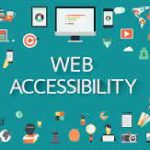With every decade, the world becomes more diverse and the word almost takes on a new meaning with every step toward progress and development. With the increasing diversity, the need for inclusion has become a necessity. Thus, businesses across the globe have drafted policies to make the workplace more inclusive. But many of these organizations are still unaware of the fact that diversity not only means the inclusion of individuals of varying race, gender, religion, ethnicity, and sexual orientation but also the inclusion of people with disabilities.
How to Encourage Diversity & Inclusivity at the Workplace
Although incorporating accessibility features can prove advantageous for a growing business, many organizations fail to do so. The concept of diversity and inclusion has become much broader yet the majority of organizations overlook accessibility due to lack of awareness, resources, or because of logistical challenges. As per a Glassdoor report, 67 percent of job seekers consider workplace diversity an important factor when considering employment opportunities, and more than 50 percent of current employees want their upper management to do more to increase diversity.
Here are a few ways that can help an organization makes its workplace more diverse and inclusive:
Ensuring People with Disabilities are Part of the Workgroup
This is by far the most important step in a series of steps to become more inclusive. Title I of the ADA was designed to ensure equal employment opportunities for individuals with disabilities. If people with disabilities aren’t part of the workgroup, then implementing other accessibility-related protocols would prove to be futile. According to the U.S. Bureau of Labor Statistics, in 2019 only 19.3 percent of persons with a disability were employed, whereas, the percentage of employed people without disabilities was 66.3. An organization’s HR staff have to be trained with regard to recruitment of people with disabilities and ensure a bias-free interview of disabled candidates. Hiring employees with disabilities has many advantages in addition to paving the way for workforce equality. For instance, numerous studies have shown that people with disabilities have a higher retention rate compared to their able-bodied counterparts. They are also more reliable and mindful of designs and solutions that are universally workable.
Integrating Accessibility into the Work Environment

A majority of people have a misguided notion that accessibility is a term linked to people with disabilities alone. On the contrary, accessibility is for everyone. Services that are made accessible wouldn’t just serve people with disabilities but cater to able-bodied individuals as well. First, if people with disabilities are a part of a workplace, it is the organization’s responsibility to start integrating accessibility within the organization. This may include physical services such as accessible toilets or wheelchair-accessible bathrooms, or digital services such as devices with screen readers, accessible user interfaces, etc. These products and/or services need to be made accessible. Web accessibility, in particular, is crucial as most brands in this digital age advertise their products online. A well-structured website replete with all accessibility features will not only increase the number of website visitors but also make for a rich user experience.
Making Other Employees Cognizant of the Difficulties a Disabled Person Faces
Even in this day and age, people with disabilities don’t get to enjoy many of the same rights that able-bodied individuals often take for granted. As a result, many of them live in isolation and have trouble socializing. On the other hand, disabled people who are employed face difficulties such as lack of disabled-friendly accommodation, accessible transport services, and so on. Sometimes, coworkers can be insensitive to people whose disabilities aren’t apparent. Also, employers often tend to overlook or underestimate the potential of a person with disabilities in completing a task. Sensitizing coworkers to the travails of their disabled counterparts can go a long way in fostering a positive work environment for one and all.
Adopting New Policies That Blend in with the Diverse Work Environment
Company policies tend to change as a business grows. Implementing new policies that complement the work culture may sustain the diversity for years to come. These policies should also take into account accessible measures that need to be taken, HR policy, non-discrimination law, code of conduct, and the accommodation and transport services provided. Making a company’s accessibility policy public is a great way of promoting the company’s diverse work culture, plus it enhances the public image of the company.
There are plenty of advantages associated with making a workplace more diverse and inclusive. Some of which are:
The Economics of an Accessible Environment
People with disabilities can work without any discomfort in an environment where accessibility measures are implemented, thereby significantly increasing their contribution to the company. Also, due to the high retention rate of people with disabilities, unnecessary expenditure on new recruitments and employee training is greatly reduced. Making digital content and website accessible tends to enrich the user experience, improve search engine ranking, and increase the visibility of said content. As accessible content has a wider reach, as a result, the customer base starts to grow, and with that the company’s overall revenue. In some countries, the government promotes a diverse work culture and accessibility by giving tax credits and incentives.
The Curb-Cut Effect
The curb-cut effect originated when some folks came up with the idea of making sidewalks accessible to wheelchair users. This, in turn, made other activities like riding bicycles, pushing strollers, and using crutches easier. The lesson to be learned here is that designs made to benefit people with disabilities can have a positive impact on the larger population as well. This doesn’t apply to physical accessibility alone but translates to the digital space as well. For example, closed captions and transcriptions were initially implemented to help people with hearing problems but surveys indicate that their usage is now higher among the able-bodied population. This includes students learning a new language or those that don’t have a good grasp of certain languages.
The Domino Effect
During the nineteenth century, when the industrial revolution started, the Luddites, a group of textile workers, destroyed textile machinery as a form of protest. They believed that machines destroyed their livelihood. On the contrary, these machines later benefitted every stakeholder, reduced manual labor and helped in ramping up production. Soon, the cost of these machines reduced and they became affordable. The same goes for accessibility and assistive devices. Large-scale production and implementation of assistive technologies will help lower the cost of consumer-grade accessible goods and services. This essentially means that as more and more companies start adopting policies aimed at improving accessibility, the widespread adoption will encourage other entities to follow suit and bring about a societal change.
Innovation, Productivity, and Commitment
Several surveys indicate that diverse and inclusive workplaces tend to produce better products and outcomes. Unconscious bias and false perceptions are shackled in a diverse environment facilitating the production of robust products. Plus, people with disabilities are highly committed too. According to a University of Waterloo study, about 86 percent of employees with disabilities are rated average or better on attendance compared to their peers while 90 percent are rated average or better on performance. Due to the high commitment of these employees, the attrition rate remains low in these workplaces. Statistics also reveal that diversity creates an overall positive environment and that employee happiness and well-being tend to be much higher in such environments.
Conclusion
A happy and productive workforce is what any company hopes for. When companies claiming to possess an inclusive work culture do not have a single disabled person on their payroll, the concept of diversity itself takes a massive hit. It’s time companies realize that cultivating a diverse work culture gives access to a larger talent pool, improves the image of the company, and also shields the company from accessibility lawsuits.
One of the important things to bear in mind is that people with disabilities are just as capable as anyone else. What they need is a level playing field and this can only be achieved by incorporating accessibility measures not just in the workplace but across every facet of their lives.






